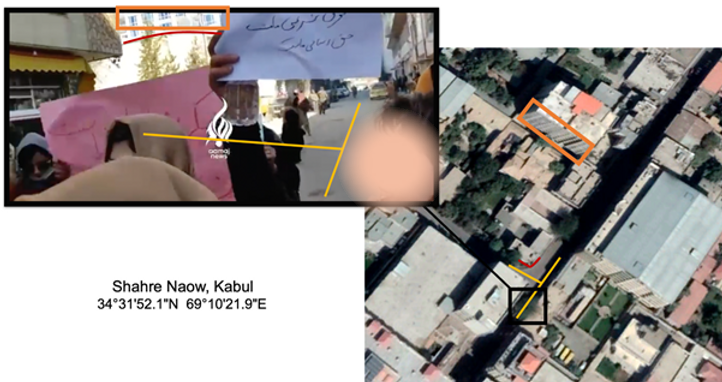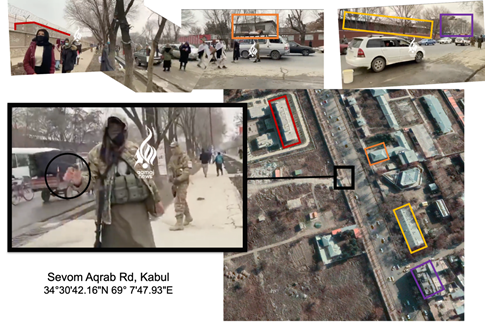“Protest by SAAJS in Kabul on Human Rights Day” by SAAJS is marked with CC BY-NC-SA 2.0.
On the night of January 19, Taliban fighters reportedly raided the homes of several female activists in Kabul.
Afghan women’s rights once again came under the spotlight after the detainment of activist Tamana Paryani and her three sisters, which made international news following a video Paryani posted on Twitter. On the same night, another activist, Parwana Ibrahimi, was also reportedly detained after her home was raided by Taliban forces.
These events are set against a backdrop of outdoor and indoor protests that have taken place across Afghanistan in recent weeks, which are clustered around the cases of specific high-profile women, Zeinab Abdullahi and Alia Azizi, as well as the detention of Ustad Faizullah Jalal, a prominent university professor.
These protests have been used as vehicles to campaign on wider issues, including access to work, quality of life, and opposition to the wearing of the burqa – the latter of which has been focused upon by Taliban and pro-Taliban figures in their pushback.
There has been a notable uptick in public protest in Kabul, while the trend of indoor protests has continued and spread to different provinces, which, until recently, had not seen any protests, such as the Baghlan, Kapisa and Jawzjan Provinces.
Indoor protests – which are usually photographed and filmed, then posted on social media – have been favoured in some instances due to there being a lesser risk of arrest or force from the Taliban.
AW have tracked the women-led protests staged throughout January, and have identified any notable trends, messages or responses:
On January 5, a group of women staged a protest indoors in the Baghlan province. The women chanted: “bread, work and freedom”, calling on the Taliban to end gender discrimination. This indoor protest marked the first-known protest in Baghlan province.
On January 7, a group of women protested indoors in Kabul whilst wearing men’s clothes – symbolising a rejection of the Taliban’s restrictions on women.
On January 7, a video posted on Twitter showed a small group of women staging an indoor protest in the Kapisa province. The women protested against the Taliban imposing restrictions, saying that women should be given human rights, further protesting against the Taliban’s harsh measures and Afghan women’s deprivation of work and education. The protesters showed slogans such as “bread”, “work”, “freedom”, and “justice”, stating that they would fight for justice and equality. This indoor protest marked the first-known protest in Kapisa province. Some of the protesting women were allegedly later arrested by the Taliban.
On January 9, several women were filmed in a video posted on Twitter staging an outdoor protest after the detention of Ustad Faizullah Jalal, a professor at Kabul University, who was arrested after allegedly publicly criticising the Taliban on Twitter and television. Further footage from the same protest that was posted on Twitter appeared to show Taliban members blocking and partially-surrounding the protesting women.
 Figure 1: Geolocation of Taliban members blocking protesting women.
Figure 1: Geolocation of Taliban members blocking protesting women.
On January 9, a number of women staged an outdoor protest in Kabul. The women stated that they have turned to graffiti in Kabul and other provinces to demand equality and protest the current situation for women in Afghanistan. These women have called on the Afghan people to express their demands for human rights and the rule of law.
On January 11, A group of women protested outdoors in Kabul against the forced veil and campaigned for the protection of women’s rights. In multiple videos posted online, the Taliban could be seen blocking the protesters’ movement.
 Figure 2: Geolocation of video showing Taliban members blocking a female-led protest.
Figure 2: Geolocation of video showing Taliban members blocking a female-led protest.
On January 12, a group of women wearing the burqa staged an indoor protest in Jawzjan. This indoor protest marked the first known anti-Taliban protest in Jawzjan province. In the video posted on social media, the women issued a resolution, stating that the Taliban have not changed and are lying to the international community. The women further stated that the Taliban “are violating their rights” and called upon the international community “to pay attention to their situation.”
On January 12, a video surfaced showing a burqa hung against a post being burnt (Twitter) by an unidentified woman who remains out of shot.
On January 13, a group of Hazara women held a protest in Kabul, demanding the release of Alia Azizi, the former head of the women’s prison in Herat who was arrested in October 2021, and has been held ever since. Footage of the protest was posted from several Twitter accounts, as well as Amaaj News. On the same day, a new female-led civil society organisation called ‘the Women’s Movement for Change’ announced its existence in Kabul via Twitter.
On the same day, January 13, a group of approximately eight women staged an indoor protest in Kunduz. The protesters, all part of the so-called ‘Unity and Solidarity Team’, demanded women’s rights be respected.
On January 15, a group of approximately 16 women held a protest in Kabul against the alleged killing of Zainab Abdullahi and the protracted detention of Alia Azizi . The Taliban reportedly blocked several journalists trying to cover the protest.
On January 16, women marched in Kabul protesting against the alleged Taliban killing of Zeinab Abdullahi and the disappearance of Herat Women’s Prison director Alia Azizi, who has not been seen since her apparent detention three months ago. The protestors chanted “Justice; Justice, I’m tired of captivity” and could be seen trampling a white burqa with fake blood stains, stating; “it’s a Pakistani tradition imposed on us”. A video posted online showed the Taliban using pepper spray to disperse the protestors.
 Figure 3: Geolocation of Taliban members using pepper spray on female protesters
Figure 3: Geolocation of Taliban members using pepper spray on female protesters
On January 17, a small number of women staged an indoor protest in Parwan province. The women protested against the killing of Zainab Abdullahi and the detention of Alia Azizi. The women stated they do not “want to live under Taliban captivity”, “Bread for the hungry”, “Restriction of freedom is the cause of this ruin”, “Freedom of expression, I will not live without you” and “You took my clean soil, do not take my work and bread”. The protesting women stated that they are defending their rights and stressed that they do not accept the Taliban’s restrictions. According to them, freedom and education are within their basic rights.
On January 22, a photograph posted on Twitter showed a group of women protesting outside in Bamyan province. The women protested against the Oslo meeting, and called for the release of protesting girls in Kabul and Alia Azizi.


